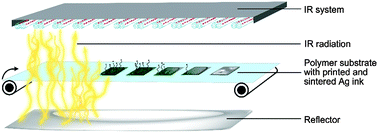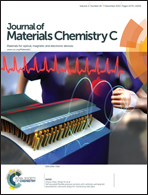Roll-to-roll infrared (IR) drying and sintering of an inkjet-printed silver nanoparticle ink within 1 second†
Abstract
Drying and sintering of conductive nanoparticle inks for printed electronics attracts more and more interest. Sintering can be performed not only by conventional thermal heating (e.g. using a hot plate or an oven), but also by alternative sintering methods such as microwave, laser, intense pulsed light (IPL) sintering and others. It was recognized that most of the sintering processes limit the feasibility of roll-to-roll (R2R) processing due to the long time duration required for the sintering. In this contribution, we report about R2R IR drying and sintering of inkjet-printed silver (Ag) layers on a non-absorbent polyethylene naphthalate (PEN) substrate. A tailored IR module was developed and installed in a R2R printing system. We demonstrated the high potential of the IR post-treatment technology resulting in a conductivity of up to 15% of that of bulk Ag. In comparison to a conventional hot plate drying and sintering the conductivity achieved using the IR approach was more than doubled. By optimization of the presented IR parameters, drying and sintering was achieved at high web velocities up to 1 m s−1 with an exposure time of less than 0.5 s.


 Please wait while we load your content...
Please wait while we load your content...